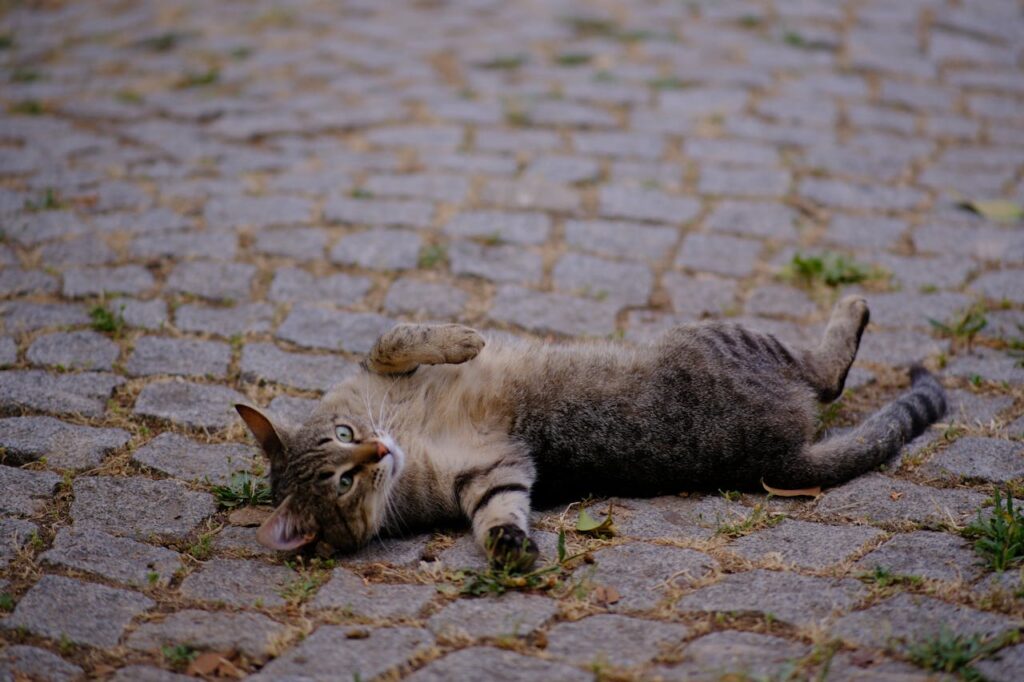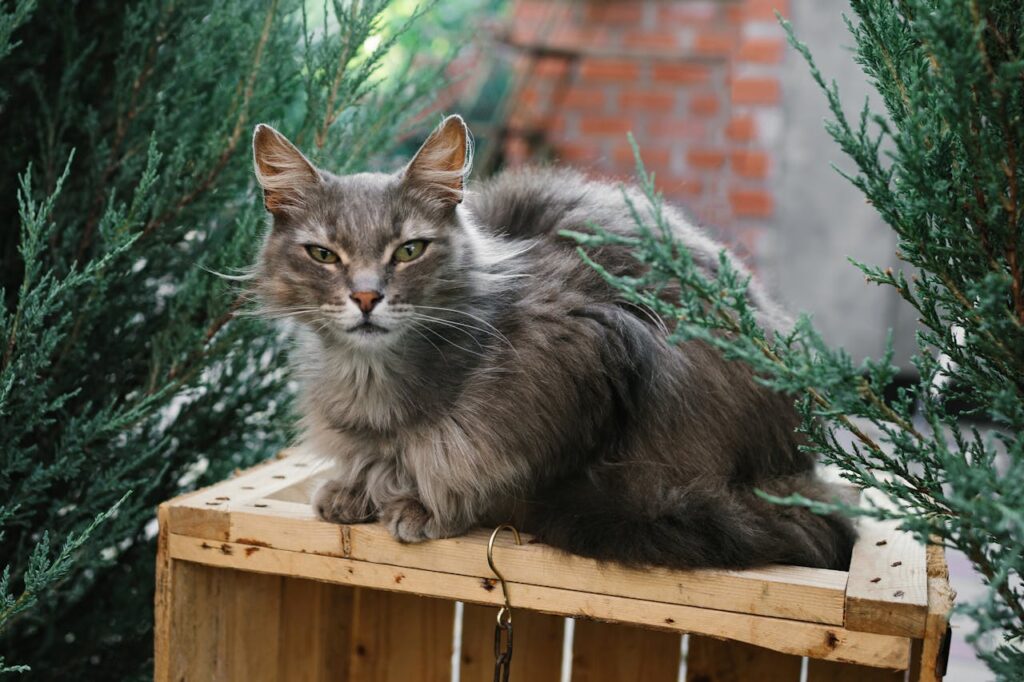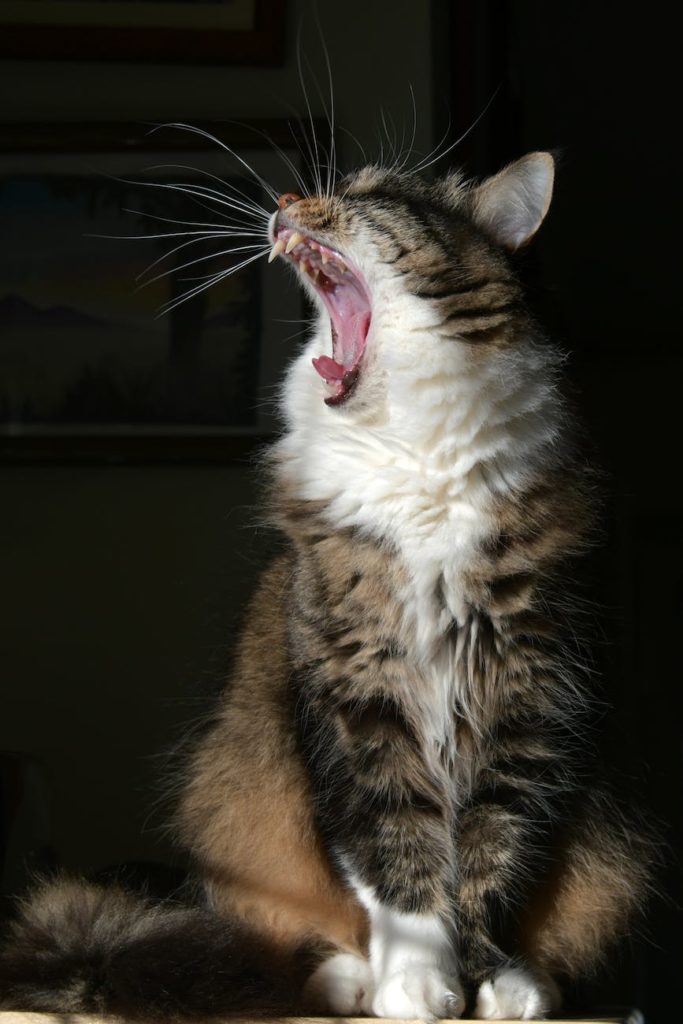Understanding the Causes and How to Stop It
Directed Aggression in Cats
At some point in their lives, almost every cat will exhibit aggressive behavior towards another cat, animal, or human. This can be a challenging behavior for pet owners to manage, especially when it is redirected aggression. Redirected aggression in cats occurs when a cat, unable to attack the object of its frustration, turns its aggression onto a nearby animal or person.
This behavior can be dangerous and potentially harmful to both the cat and the object of the aggression. In this article, we will explore the causes of redirected aggression in cats and provide some tips on how to stop it.

Table of Contents
Taming the Tempest
Redirected aggression is a common behavior among our feline companions, yet it remains one that many cat owners struggle to comprehend. Essentially, redirected aggression occurs when a cat is aroused by a stimulus—such as the sight or sound of another animal—resulting in aggressive behavior directed toward a nearby target instead of the original trigger. Directed Aggression in Cats. For instance, if a cat sees a bird outside and becomes excited or agitated, it may turn its aggression on a nearby family member or another pet.
Understanding this behavior is crucial for any cat owner. When redirected aggression occurs, it often leaves the recipient of the cat’s focus frightened and confused. A further understanding of the behaviors that lead to aggression in cats allows owners to manage their pets more effectively. Additionally, recognizing the signs of stress in cats, which can include hissing, growling, or swatting, is vital for addressing these aggressive episodes head-on.
1. Identify and Manage Triggers
Understanding and managing triggers is foundational in addressing redirected aggression in cats. Each feline possesses a unique personality, and the stimuli that evoke aggressive reactions can widely differ. Therefore, attentive observation of your cat’s behaviors in various situations is crucial. For example, some cats may react strongly to the rustle of leaves outside, the chirping of birds, or the mere presence of another cat in the vicinity. Other cats might be sensitive to certain loud noises, such as thunder or fireworks, which could create an anxious and aggressive atmosphere.
To pinpoint your cat’s triggers, maintain a detailed journal of their behavior over several weeks. Note the specific circumstances surrounding each aggressive incident, including the time of day, the environment, and any observed patterns. Directed Aggression in Cats. This method can help you identify recurring triggers. Once you have a clear list of what specifically instigates aggressive behavior, you can take proactive steps to manage or eliminate these triggers from your cat’s environment.
For instance, if your cat becomes aggressive when confronted with another cat, you could consider separating them during peak activity times, such as feeding or late evening when household activity increases. Directed Aggression in Cats. Similarly, if sounds from outside elicit aggressive behavior, soundproofing windows or using white noise machines can help disguise disruptive noises.
Moreover, enriching your cat’s environment can redirect their focus away from external triggers. Enrichment activities can include introducing new toys, scratching posts, or engaging in interactive play to keep your cat occupied. Directed Aggression in Cats. These strategies will not only reduce exposure to triggers but will also provide mental stimulation that is vital for your cat’s well-being.
2. Create a Safe Haven
A safe haven is essential for every cat, serving as a sanctuary where they can retreat when feeling anxious or overwhelmed. This designated area should be a stress-free zone, furnished with comforting elements that cater to their needs. Directed Aggression in Cats. When setting up a safe space, think about elevated perches or secluded spots where your cat can feel secure while observing their surroundings without the fear of being cornered or threatened.
In addition to physical security, it’s essential to consider the sensory aspects of your cat’s safe haven. Ensure it is away from loud noises, bustling activity, or direct sunlight, which could cause discomfort. Directed Aggression in Cats. Plush bedding, soft blankets, and familiar toys contribute to a positive, comforting atmosphere. You could also enhance the environment by introducing calming scents, such as lavender or chamomile, which can have soothing properties for both cats and humans.
Moreover, consider investing in products designed specifically for anxiety relief. Directed Aggression in Cats. Calming pheromones, available in spray or diffuser form, can significantly help alleviate anxiety in cats. These pheromones replicate scents that mother cats emit to comfort their kittens, creating a sense of reassurance in your home. Incorporating classical music or nature sounds can also help maintain a serene ambiance that fosters relaxation.
Creating a safe haven allows your cat to regroup and recharge when they feel overwhelmed, significantly reducing the chances of redirected aggression. This refuge provides them with a comforting space to de-stress, ultimately contributing to their overall emotional well-being.
3. Implement Regular Playtime and Stimulation
Playtime is not just a fun activity; it is a critical component in preventing aggression in cats. Regular engagement in play allows cats to channel their natural hunting instincts into safe and acceptable behaviors. Directed Aggression in Cats. Activities such as chasing feather wands, pouncing on laser pointers, or solving interactive puzzle feeders stimulate their minds and provide ample physical exercise.
Scheduling consistent play sessions each day can keep your cat’s energy levels balanced, thus diffusing the potential for aggression. Choose a variety of toys to maintain your cat’s interest and keep their environment stimulating. Directed Aggression in Cats. Toys that mimic the movements of prey, such as feather wands or remote-controlled mice, can be particularly engaging.
Additionally, consider the timing of play sessions. If you notice a pattern where aggression tends to spike—such as during feeding times or when new stimuli occur—try scheduling playtime before these peak moments. Directed Aggression in Cats. This helps to use up excess energy and serves as a distraction from potential triggers.
Moreover, prioritizing bonding time between you and your cat during play strengthens your relationship. A strong bond fosters trust, which is crucial in ensuring your cat feels safe and secure in their environment. Directed Aggression in Cats. When your cat sees you as a source of fun and positive interactions, they are more likely to respond to you during stressful moments, which can help mitigate aggressive behaviors.
4. Use Calming Aids
In today’s world, many resources are available to help calm anxious or aggressive cats. Calming aids are designed to create a soothing environment conducive to relaxation. Directed Aggression in Cats. For example, pheromone diffusers work by mimicking natural odors that promote feelings of safety and comfort for cats. These diffusers release synthetic pheromones into the air, which can significantly reduce stress-related behaviors.
Apart from pheromones, consider herbal remedies such as chamomile or valerian root, which are known for their calming properties. Various supplements on the market also contain ingredients specifically aimed at reducing anxiety in pets. Directed Aggression in Cats. However, it is imperative to consult your veterinarian before introducing any new products to your cat’s routine. Your veterinarian can recommend specific products based on your cat’s individual needs and health status.
You may also want to explore holistic treatments such as acupuncture or massage therapy, which can help alleviate anxiety and stress in cats. Directed Aggression in Cats. Many cats benefit from gentle physical touch, which can be a calming influence. Working with a veterinarian knowledgeable about feline wellness can guide you in selecting the best approach for using calming aids effectively.
Creating a comprehensive strategy by combining calming aids with environmental modifications and behavioral training will create a more robust framework to address redirected aggression.
5. Establish Routine and Predictability
Cats are creatures of habit, and they thrive on routine. A predictable environment helps reduce anxiety and fosters a sense of security. By establishing a structured schedule for feeding, playtime, and rest periods, you can create an atmosphere where your cat feels at ease. Directed Aggression in Cats. Consistency is key; regular routines help your cat anticipate daily activities, minimizing the stress that sudden changes may incite.
For instance, it’s helpful to feed your cat at the same time every day. If you notice a spike in aggression during feeding, ensure that they have their own safe space to eat without competition from other animals. Directed Aggression in Cats. Following a regular schedule for playtime offers your cat an outlet for energy, while allocating quiet periods ensures they have the necessary downtime to relax.
Transitioning to a more predictable routine may require adjustments to your own schedule, but the long-term outcomes largely outweigh any temporary inconvenience. By observing your cat’s responses to different activities, you can fine-tune your routine to better suit their specific characteristics and preferences.
In cases where environmental changes are unavoidable—relatives visiting, moving to a new home, or other disruptions—consider maintaining as much of the routine as possible. This continuity will reassure your cat and help them navigate potentially stressful situations without resorting to aggression.
6. Consider Behavioral Modification Techniques
Behavioral modification can be crucial in addressing aggressive tendencies in cats. Techniques rooted in positive reinforcement encourage desirable behaviors while gently discouraging aggression. Training your cat using rewarding methods fosters a positive association with specific behaviors, leading them to repeat those behaviors in the future.
When your cat exhibits calm behavior or engages in appropriate forms of play, promptly reward them with treats, praise, or petting. Directed Aggression in Cats. This not only reinforces their positive behavior but also shifts their focus from aggressive actions to constructive engagements. For instance, if your cat remains calm during a situation that would typically provoke a reaction, such as when another cat passes by a window, offering a reward can strengthen the behavior you want to encourage.
In more challenging or severe cases of aggression, seeking the guidance of a certified animal behaviorist can be beneficial. Directed Aggression in Cats. These professionals can provide individualized training programs tailored to your cat’s needs, addressing specific instances of redirected aggression. They may suggest techniques such as counter-conditioning, scripting their environment, or gradually introducing them to challenges while maintaining control over their reactions.
Empowering pet owners with the right tools and knowledge not only helps prevent aggressive outbursts but also nurtures a more harmonious relationship between cats and humans. Directed Aggression in Cats. Understanding feline behavior and learning how to communicate effectively can lead to a deeper bond and mutual respect.

7. Desensitize Your Cat to Triggers
Desensitization is a valuable technique in managing redirected aggression. This method involves gradually acclimating your cat to potential triggers in a controlled, non-threatening manner. By slowly introducing the stimuli that typically provoke aggressive reactions, you can help your cat learn to cope with these triggers without resorting to aggression.
Begin with low-level exposure to the trigger, allowing them to observe it from a safe distance or position. Directed Aggression in Cats. For instance, if your cat becomes agitated by the sight of a dog in the neighborhood, start by allowing them to observe the dog from a window while engaged in a rewarding activity. Gradually decrease the distance or increase the intensity of the exposure only as your cat shows signs of comfort and reduced anxiety. Patience is essential in this process; each cat is unique and may require varying amounts of time to adjust.
As your cat demonstrates improved tolerance toward the trigger, consistently reward them with treats or praise during and after exposure. Directed Aggression in Cats. This positive reinforcement reassures your cat that they are in a safe environment, gradually reducing their reactivity.
Make sure to monitor your cat’s body language throughout this process. Signs of anxiety, such as flattened ears or quickened breathing, indicate that you may need to slow down and allow your cat more time to acclimate. Directed Aggression in Cats. The goal of desensitization is to create a scenario where the presence of the previously aggressive-inducing stimulus is nothing more than a neutral or even positive experience for your cat.
8. Foster Inter-cat Relationships
When there are multiple cats in a single household, redirected aggression can occur due to competition, territorial disputes, and social hierarchies. Directed Aggression in Cats. Building harmonious relationships among your feline companions requires intentional effort, management of resources, and understanding of individual personalities.
One effective strategy is to offer multiple food and water sources throughout the home. This approach decreases competition at mealtimes, reducing tension between cats. Directed Aggression in Cats. Similarly, providing multiple litter boxes—ideally one more than the number of cats—helps prevent territorial disputes and promotes healthy habits.
Creating separate territories can also help your cats develop their own spaces and minimize feelings of insecurity. Each cat should have access to safe spaces where they can confidently retreat to find solitude without feeling threatened by others. Consider using baby gates or screen doors to create separate areas, allowing for controlled interactions while maintaining personal zones.
Gradual introductions play a vital role in fostering relationships among cats. When introducing new cats into the household, do so in a slow, controlled manner. Use scent swapping and gradual visual introductions to allow each cat to adjust to the presence of the other without feeling overwhelmed. Pair these introductions with positive experiences, such as treats or playtime, to build a positive association between them.
Recognizing and respecting individual personalities is equally important. Not every cat is going to get along immediately, and some may never become the best of friends. Allowing them to establish their territory can help minimize conflicts. Over time, with proper management and care, your household can develop into a more peaceful environment where all cats feel safe and secure.
9. Consult a Veterinarian
If redirected aggression persists despite your best efforts, it is essential to consult with a veterinarian. Aggressive behaviors in cats can often have underlying medical conditions contributing to their discomfort and irritability. It’s critical to rule out any potential health issues that might be affecting your cat’s behavior, including pain, mental health challenges, or conditions like hyperthyroidism or dental disease.
Your veterinarian can conduct a comprehensive assessment, including physical examinations, behavioral evaluations, and any necessary tests. They are equipped to diagnose these underlying issues and work with you to develop a nuanced, multi-faceted plan that might include behavioral modifications, environmental enrichment, and, if necessary, medications.
In cases where behavioral interventions alone do not yield the desired results, your veterinarian may suggest medication as a potential option to help your cat better cope with anxiety and aggression. Pharmaceutical interventions should be viewed as a last resort, with the understanding that behavioral modifications, environmental adjustments, and calming aids are typically the first line of treatment.
Through the guidance of a veterinarian, you can receive personalized recommendations tailored to your cat’s specific needs, ensuring the best possible outcomes in managing redirected aggression effectively.
In summary, addressing redirected aggression in cats requires a comprehensive approach that combines environmental management, behavioral modification, and medical consultation if necessary. By understanding your cat’s unique triggers and needs, you can create a safe and enriching environment that minimizes aggressive tendencies and fosters a harmonious relationship between you and your feline companion. Patience and diligence in implementing these strategies can lead to significant improvements in your cat’s behavior, ultimately enhancing the quality of life for both you and your furry friend.
Building a Harmonious Environment
Redirected aggression in cats can be challenging to navigate, but with the right strategies, owners can create a harmonious environment for both their cats and themselves. Through careful observation, proactive management, and effective behavioral modifications, it is possible to mitigate instances of aggression. Remember, every cat is unique; therefore, trial and error may be necessary to discover what works best for your feline companion.
Creating a sanctuary of safety, providing mental stimulation, and fostering positive relationships with fellow pets helps build trust and security in your home. With time, patience, and love, you can transform your cat’s aggression into a peaceful coexistence, paving the way for a happier, healthier life together.
Causes of Redirected Aggression in Cats
There are many reasons why a cat may exhibit redirected aggression, but some of the most common ones include:
Lack of socialization: Cats that are not socialized properly can become stressed and anxious when introduced to new situations, people, or animals.
Territoriality: Cats are territorial animals, and they may feel threatened when another animal or person enters their space.
Fear: Cats may become fearful of a particular object, person, or animal, and when they are unable to escape, they may become aggressive.
Pain or illness: Cats that are in pain or are suffering from an illness may become irritable and more likely to exhibit aggressive behavior.
How to Stop Redirected Aggression in Cats
Identify the trigger: Identifying the trigger of your cat’s aggression is the first step in managing this behavior. Once you have identified the trigger, you can take steps to remove it or modify your cat’s behavior.
Provide a safe space: Provide your cat with a safe space where they can retreat when they feel stressed or threatened. This can be a separate room or a quiet corner of your home.
Use positive reinforcement: Use positive reinforcement to reward your cat for good behavior. This can include treats, toys, or affection.
Consult with your veterinarian: If your cat’s aggression is caused by pain or illness, your veterinarian can provide medication or other treatments to help manage this behavior.
Consider professional help: In some cases, it may be necessary to consult with a professional behaviorist or trainer to help modify your cat’s behavior.
Live Pee Free! Odor Eliminator 100% Eliminates Pet Odor on Contact. 20% Off. No Enzymes, No Fragrance, No Detergent, No Bleach – Safe for Kids and Pets.Conclusion
Redirected aggression in cats can be a challenging behavior for pet owners to manage, but with the right approach, it can be stopped. By identifying the trigger of your cat’s aggression and providing a safe space, using positive reinforcement, consulting with your veterinarian, and considering professional help, you can help your cat overcome this behavior and live a happy, healthy life.




